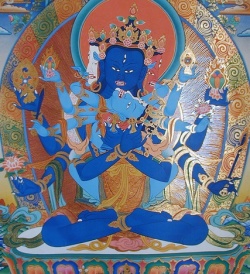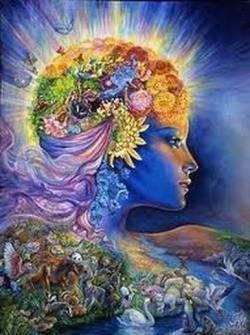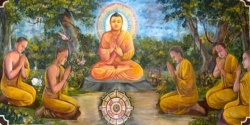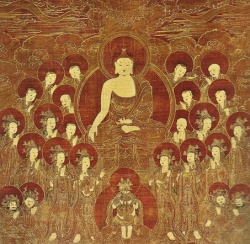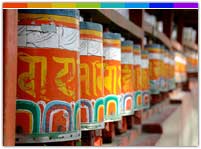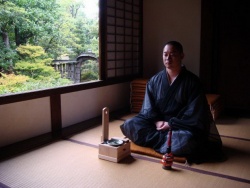Guhyasamaja
Click here to see other articles relating to word Guhyasamaja
Guhyasamaja (Skt. Guhyasamāja; Tib. གསང་བ་འདུས་པ་, Wyl. gsang ba 'dus pa) is a manifestation of Buddha Akshobhya.
Guhyasamaja (Tib.: sang wa du pa, Eng.: the secret assembly): the principal anuttarayoga tantra of the method (father) classification. Sakya maintains two principal lineages; Akshobhyavajra of Nagarjuna (Phag Lug) and Manjuvajra of Jnanapada (Yeshe Lug).
External Links
Source
Akshobhyavajra, Guhyasamaja(Tibetan: ''mi kyo dor je sang wa du pa,
English: The Secret Assembly, Unshakable Vajra Scepter):
The chief tutelary deity of the Father (method) classification of Anuttarayoga Tantra.
Bodhisattva-aspect of the water element(Buddha Akshobhya),embraced by his female consort.
His seed syllable is the blue HUNG.He embodies all wisdom qualities and magical powers of the six elements,symbolized by the attributes in his hands like vajra(water), wheel (ether), lotus (fire),jewels (earth), wisdom sword(air).
His crossed hands holding vajra (male)and gantha (bell/female)symbolize the primordial, nondualistic state of his mind.
Source
Guhyasamaja (Tibetan Sangwadupa, sometimes abbreviated to Sangdu) means Secret Assembly.
The full title of the Guhyasamaja Tantra literally means 'the secret union of the body, speech, and mind of all the Tathagatas'.
This tantra is concerned to produce an experience of Enlightened consciousness that is without beginning or end, whose nature is the union of wisdom and luminosity.
The Guhyasamaja Tantra was one of the earliest to be committed to writing.
Tradition has it that King Indrabhuti of Uddiyana saw some monks, whose spiritual realization had given them supernormal powers, flying in the air over his lands.
He wanted to emulate them, but insisted that he would need a method of meditation suitable for those who had not renounced sense-pleasures.
In response, Sakyamuni taught him the Guhyasamaja Tantra.
By following this practice the king and all the people of Uddiyana attained Tantric realization.
The teaching was then conveyed to another king in southern India called Visukalpa, who taught it to Saraha, the mahasiddha whose name is also associated with Cakrasamvara, who then gave it to Nagarjuna.
It was then preserved orally, until written down by Asanga.
It entered Tibet during the early spread of Buddhism there, and a number of Nyingma lamas wrote commentaries on it.
It was retranslated in the eleventh century by the Tibetan monk Rinchen Zangpo (958-1055), known as the Great Translator.
The Guhyasamaja Tantra has had a profound effect on Tantric Buddhism. In its first chapter, the adi- (or primordial) Buddha - i.e. absolute Reality beyond time and space - gives birth, through the power of mantric sound, to the entire mandala of the five Buddhas with their consorts.
(In this case, Aksobhya (imperturbable) inhabits the centre of the mandala, and Vairocana (illuminator) sits in the east.)
There are two main schools of Guhyasamaja practice: the Arya school, whose central teacher was Nagarjuna, and the school derived from Jhanapada.
In the Guhyasamaja system, any one of several deities can be the central figure of the mandala.
In the Jnanapada school it is Avalokitesvara.
In the Arya school, two main mandalas are meditated upon.
In one the central figure is Manjuvajra, a form of Vajrasattva.
However, the most important figure in the main mandala of the Arya school, is Aksobhyavajra.
It is this figure that is often just described as Guhyasamaja in books and catalogues of Tibetan thangkas and images, and it clearly relates to chapter I of the Tantra.
It is a beautiful deep-blue, seated form, in sexual embrace with the light-blue consort Sparaavajra.
Both yab and yum are smiling (though the mother is said to be very fierce), and decked with silks and jewels.
They each have three faces: blue, red, and white.
Their blue principal faces are close to each other, with the others on either side.
They represent the transmutation of passion, aggression, and ignorance into expressions of wisdom.
Each face is adorned with a third, wisdom eye in the forehead.
The yab sits in the vajra posture, with the yum in his lap, her legs encircling his waist in sexual embrace.
The figures have six arms.
The yab embraces the yum with his principal arms, his crossed hands holding a vajra and bell, as we saw with Cakrasamvara.
At the same time, the yum embraces the yab with two of her arms, also holding a vajra and bell.
In his other right hands the yah holds the wheel and the lotus.
In her other right hands, on the opposite side of the figure, the yum holds the same emblems.
In their other left hands both yab and yum hold a jewel and a sword.
Those familiar with the five Buddhas of the mandala will recognize their emblems:
Vairocana's wheel,
Amitabha's lotus,
Ratnasambhava's jewel, and
Amoghasiddhi's sword (though his emblem is more commonly the double vajra).
In the Guhyasamaja system, Aksobhya occupies the centre of the mandala, so the figure's central hands hold his emblem the vajra, and the vajra-bell.
This figure, once one has accustomed oneself to the strangeness of the multiple heads and arms, becomes one of the most beautiful of all Buddhist images.
It is a symbol of a psyche, and a universe, in which everything is in perfect harmony.
The faces are serene, the sitting posture has a calmer feel than the dancing and trampling of the other yidams we have met.
Yab and yum perfectly mirror each another in their hand positions and emblems.
They, and all the opposites they represent, are in total accord.
Even the two sides of the figures are in balance.
Drawing a vertical line through the centre of the figures would still leave two harmonious sides with all the six emblems.
We are in a world where opposites attain a two in- oneness, and the same cosmic laws can be demonstrated in the macrocosm or microcosm.
The Father and his consort are seated in the middle of a mandala palace surrounded by thirty other deities.
Once again we have symbolism of the connectedness of macrocosm and microcosm, for the retinue of the central pair, who themselves hold the emblems of the five Buddhas, includes Vairocana, Ratnasambhava, Amitabha, Amoghasiddhi, and their consorts.
Guhyasamaja is a particularly important yidam for the Gelukpas.
Their two main Tantric colleges, the Gyuto and Gyume, which used to be based in Lhasa, both gave great prominence to the practice of his sadhana, and the Guhyasamaja system is used by the Gelukpas as the paradigm for approaching an understanding of other Highest Tantra systems of practice.
Guhyasamaja belongs to the Vajra family of Aksobhya.
His practice belongs to the Father Tantra, which concentrates on compassion and skilful means, using complex yogic methods to bring about the development of the illusory body. Father Tantra, as we have seen, is concerned with the transmutation of anger and aggression.
The Guhyasamaja Tantra is basically concerned with the realization that the universe is inherently wondrous and valuable.
This can only come about when the passions, in particular hatred and aversion, have been transmuted.
Source
A Guide to the Deities of the Tantra (Meeting the Buddhas)
librarum.org
